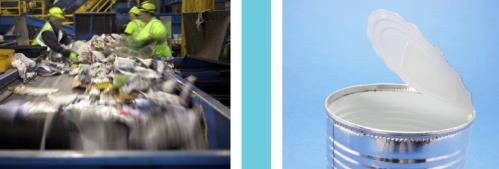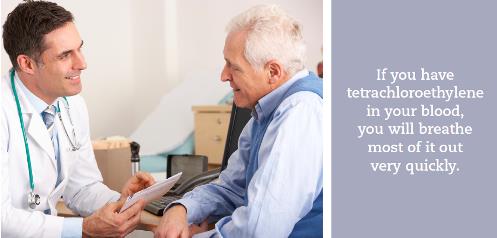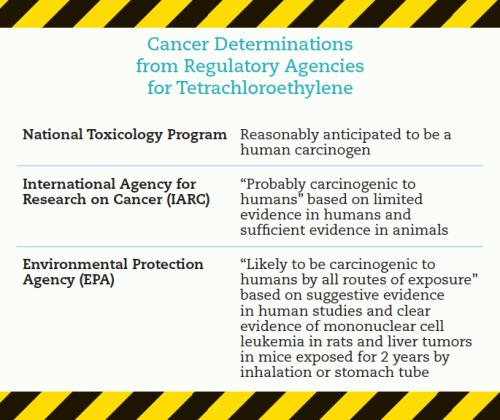
Tetrachloroethylene
On this Page
Tetrachloroethylene Overview
Tetrachloroethylene is a nonflammable colorless liquid.
 Other names for tetrachloroethylene include perchloroethylene, PCE, PERC, tetrachloroethene, and perchlor. Most people can smell tetrachloroethylene when it is present in the air at a level of 1 part in 1 million parts of air (ppm) or more.
Other names for tetrachloroethylene include perchloroethylene, PCE, PERC, tetrachloroethene, and perchlor. Most people can smell tetrachloroethylene when it is present in the air at a level of 1 part in 1 million parts of air (ppm) or more.
Tetrachloroethylene is used as a dry cleaning agent and metal degreasing solvent. It is also used as a starting material (building block) for making other chemicals and is used in some consumer products. Top of Page
Tetrachloroethylene and the Environment
Tetrachloroethylene can be released into the air, water, and soil at places where it is produced or used.
Most releases of tetrachloroethylene during its use are directly to the atmosphere. Much of the tetrachloroethylene released into the air comes from the dry cleaning industry. Some Tetrachloroethylene may be released from dry-cleaned or consumer products. Tetrachloroethylene breaks down very slowly in the air and so it can be transported long distances in the air. The average concentration of tetrachloroethylene in the air of the United States is typically less than 1 microgram per cubic meter of air, or 1 part per billion.
A variety of industries that use tetrachloroethylene (such as metal degreasing and dry cleaning) produce liquid wastes that contain the compound, which may then end up at waste treatment facilities. Tetrachloroethylene evaporates quickly from water into air, although some tetrachloroethylene may remain in the water. It is generally slow to break down in water. Tetrachloroethylene can migrate through vapors from the groundwater (or soil) up into the air of homes and buildings through vapor intrusion.
Contamination of soil can occur when tetrachloroethylene at a waste disposal site seeps out of the waste and into the soil. Tetrachloroethylene may evaporate quickly from shallow soils or may filter through the soil and into the groundwater below. It is generally slow to break down in soil because it is lipid soluble, which makes it absorb or bind to soil.
Exposure to Tetrachloroethylene
Tetrachloroethylene can enter your body from the air, water, or soil.
Tetrachloroethylene in air can easily enter your body when you breathe. Most of the tetrachloroethylene that you breathe in will go into your bloodstream and other organs. A small amount of tetrachloroethylene in the air can also move through your skin and into your bloodstream.
When tetrachloroethylene is found in water, it can enter your body when you drink or touch the water or when you breathe in steam from the water. Most of the tetrachloroethylene that you breathe in or drink will move from your stomach or lungs into your bloodstream. When you touch water containing tetrachloroethylene, some of it can get through your skin into your body, but not as much as when you breathe or swallow it.
You can be exposed to tetrachloroethylene in soil when small amounts of soil are transferred to your mouth accidentally, when your skin touches the soil, or when you breathe air or dust coming from the soil.
Tetrachloroethylene and the Body
Most tetrachloroethylene that you are exposed to will enter into your blood.
A small amount of tetrachloroethylene in your blood may be broken down to other chemicals that will leave your body in urine. If you are exposed over and over again to tetrachloroethylene, some of it may be stored in body fat and the amount can build up over time. When the exposure stops, your body will slowly get rid of the tetrachloroethylene stored in fat.
If you have tetrachloroethylene in your blood, you will breathe most of it out very quickly. A small amount of tetrachloroethylene in your blood may get changed into other chemicals that leave your body in urine.
Health Effects of Exposure
Tetrachloroethylene exposure may have an adverse effect on the nervous system, liver, kidneys, and reproductive system, and may be harmful to unborn children.
If you are exposed to tetrachloroethylene, continuously, over a long period of time, you may also be at a higher risk of developing certain types of cancer.
If you breathe in air containing a large amount of tetrachloroethylene, you may become dizzy or sleepy, develop headaches, and become uncoordinated; or you may become unconscious. Some people have died after being exposed in tanks or other small spaces, or after intentionally breathing in a large amount of tetrachloroethylene.
People who are exposed for longer periods of time to lower levels of tetrachloroethylene in air may have changes in mood, memory, attention, reaction time, or vision. Animals exposed to tetrachloroethylene have shown liver and kidney 6 effects, and changes in brain chemistry, but we currently do not know what these findings mean for humans.

Tetrachloroethylene may have effects on pregnancy and unborn children. Studies in people are not clear on this subject, but studies in animals show problems with pregnancy (such as miscarriage, birth defects, and slowed growth of the baby) after oral and inhalation exposure to tetrachloroethylene.
Studies in humans suggest that exposure to tetrachloroethylene for prolonged periods may lead to a higher risk of bladder cancer, multiple myeloma, or non-Hodgkin’s lymphoma, but the evidence is not very strong. In animals, tetrachloroethylene has been shown to cause cancers of the liver, kidney, and blood system. It is not clear whether these effects might also occur in humans, because humans and animals differ in how their bodies handle tetrachloroethylene.
Tetrachloroethylene and Children
Children may be exposed to tetrachloroethylene in many of the same ways as adults.
It is not known whether children are more susceptible than adults to the effects of tetrachloroethylene. There are very few studies available to answer this question, and many more studies are needed.
We do not know for sure whether tetrachloroethylene can cause birth defects in humans. A few human studies have suggested that exposure to tetrachloroethylene increased the numbers of babies with heart, oral cleft, or neural tube defects, but these studies were not large enough to clearly answer the question. Studies in animals exposed by inhalation or stomach tube have not.
Reducing Risk of Exposure
If your doctor finds that you have been exposed to significant amounts of tetrachloroethylene, ask whether your children might also be exposed. Your doctor might need to ask your state health department to investigate.
Tetrachloroethylene has the potential to contaminate foods, although the levels found in food are generally low. Contact local drinking water authorities and follow their advice if you have any concerns about the presence of tetrachloroethylene in your tap water. Tetrachloroethylene can be present in the indoor air of homes and apartments above dry cleaning facilities. To minimize risks associated with breathing in contaminated vapors, ensure that the area is well ventilated.
Tetrachloroethylene can also be present in groundwater and soil underneath a building or a home, resulting in above-ground vapors through vapor intrusion (movement of vapors from groundwater or soil into air). If you think that you may have groundwater contaminated with tetrachloroethylene, contact your local state health department. In addition, a depressurization system, an increase in the air exchange rate between indoor and outdoor air, or vapor barriers can reduce exposure to tetrachloroethylene through vapor intrusion. Prevent children from playing in dirt or eating dirt if you live near a waste site that is contaminated with tetrachloroethylene.
Tetrachloroethylene is widely used as a scouring solvent that removes oils from fabrics, as a carrier solvent, as a fabric finish or water repellant, and as a metal degreaser/cleaner. Follow instructions on product labels to minimize exposure to tetrachloroethylene. Storing these items in a shed or an outside location may reduce exposure and decrease the impact on indoor air. Top of Page
Exposure Testing
There are reliable ways to detect whether you have been exposed to tetrachloroethylene.
Tetrachloroethylene and its breakdown products (metabolites) can be measured in blood and urine. However, the detection of tetrachloroethylene or its metabolites cannot predict the kind of health effects that might develop from that exposure. Because tetrachloroethylene and its metabolites leave the body fairly rapidly, the tests need to be conducted within days after exposure.
Governmental Recommendations
Recommendations and regulations are also updated periodically as more information becomes available. For the most current information, check with the federal agency or organization that issued the regulation or recommendation.
Additional Information
If you have any more questions or concerns, please contact your community or state health or environmental quality department or contact ATSDR at the address and phone number below.
Agency for Toxic Substances and Disease Registry
Division of Toxicology and Human Health Sciences
1600 Clifton Road NE, Mailstop F-57
Atlanta, GA 30329-4027
Toll-free information and technical assistance:
1-800-CDCINFO (1-800-232-4636) Top of Page

- Page last reviewed: October 14, 2015
- Page last updated: October 14, 2015
- Content source:



 ShareCompartir
ShareCompartir






